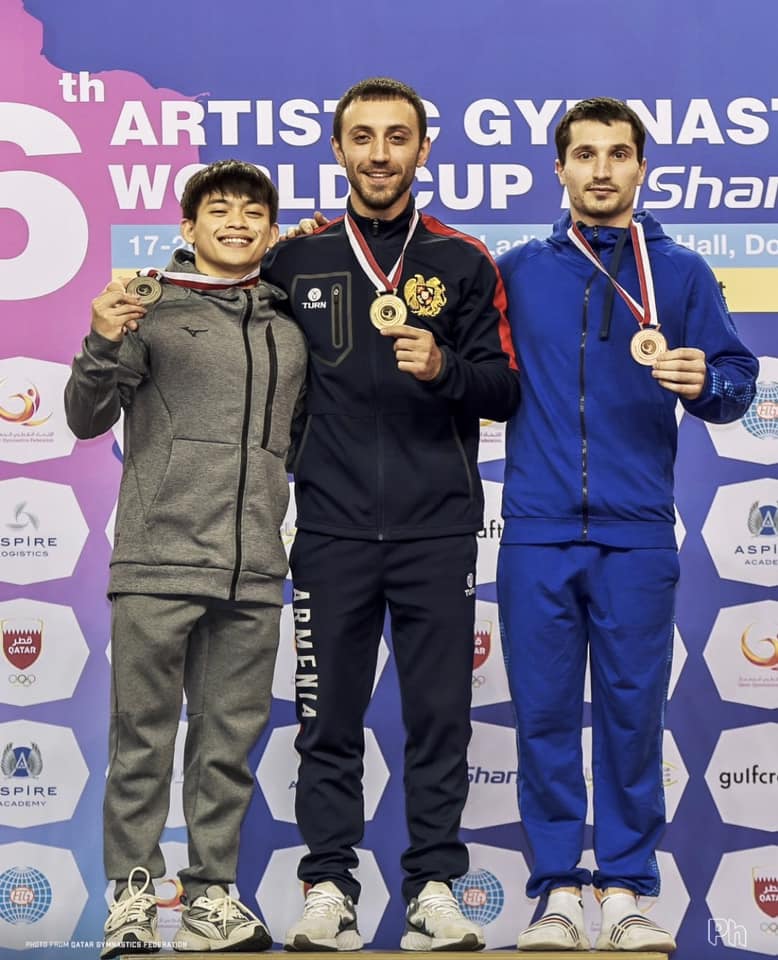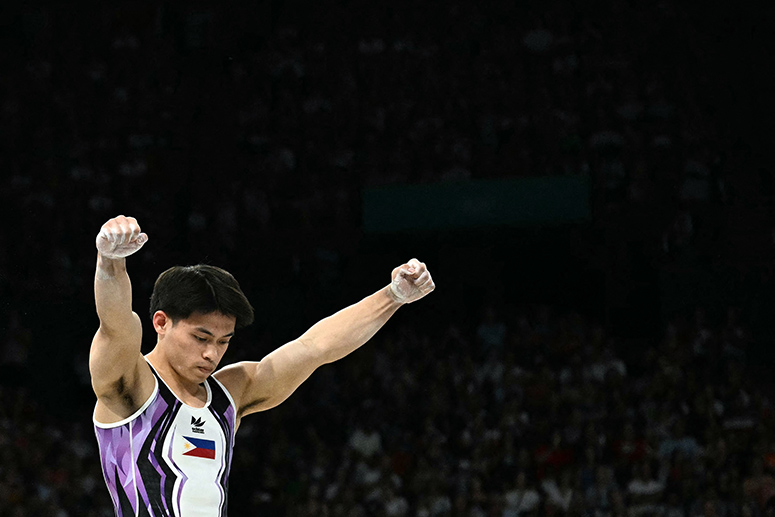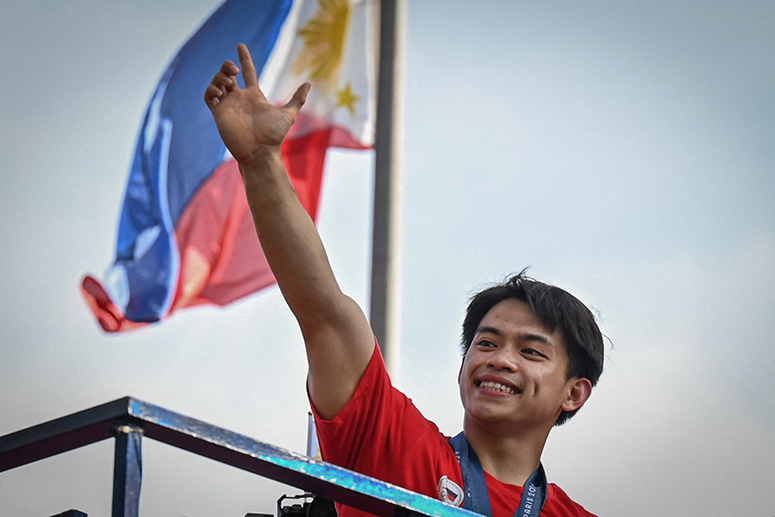[OPINION] We haven’t talked nearly enough about Carlos Yulo’s singular genius
It has barely been a couple of weeks since Carlos Yulo’s historic double gold medal victory at the Paris 2024 Olympics, but his actual performance already seems like it happened forever ago. As monumental as his achievements were, they have since been dwarfed in attention by the whole unfortunate drama with his family, especially his mother. Beyond that, the only other facet of the story that seemed to resonate with audiences around the world has been the bonanza awaiting the gymnast for winning his double gold.
What hasn’t been examined deeply (if at all) is just how singular—how impossible—Yulo’s achievement is.
Sure, we’ve produced athletes who’ve become superstars on the world stage. The first name in Philippine sports, Manny Pacquiao, is one of the very best fighters in the history of boxing.
But there is historical context for Manny Pacquiao. Boxing is maybe second only to basketball in the hearts of many Pinoy sports fans. The first world champion in our country’s history, Pancho Villa, was a boxer, as was the Philippines’ first true superstar athlete, Gabriel “Flash” Elorde, who dominated the ‘60s. The most enduring event ever held in the Philippines remains the Thrilla in Manila, the brutal classic heavyweight boxing match between Muhammad Ali and Joe Frazier. There has been a new Filipino world champion each decade since Elorde.
Boxing success has translated to the Olympics as well. We have 10 medals in Olympic boxing; no other sport has more than two.
Pacquiao is a once-in-a-century athlete. But given our boxing culture, it was only a matter of time before we produced a once-in-a-century athlete. Pacquiao was great, but it shouldn’t surprise anyone that the Philippines, with our passion for and history with boxing, was able to produce someone that great. In many ways, it was inevitable.
Just like Pacquiao, there is also context for Hidilyn Diaz, the Philippines’ first gold winner in the Olympics. While weightlifting hasn’t always been a traditional medal-rich sport for our country, it has actually been a source of glory for our neighbors.
The Southeast Asian weightlifting revolution began in 2000 when women were allowed to compete in the sport for the first time. By the time Hidilyn Diaz competed in her first Olympics in Beijing in 2008 as a wildcard entry, Thailand and Indonesia had already turned into darkhorse contenders in the sport; the Thais had won five medals, including two golds, over the two Olympics prior, while the Indonesians won four medals. Interestingly, all those first several medals were won by women.
It made perfect sense. Unlike some other sports, weightlifting does not require intensive capital investment for training. Plus, weight divisions leveled the playing field for diminutive athletes competing in the sport.
Diaz had forgettable stints in Beijing in 2008 (10th of 12) and London in 2012 (Did Not Finish). Each time, she competed against much bigger opponents in the 58kg division.
But the blueprint was there for medal success for a Filipino weightlifter, especially a woman, to make a breakthrough. All it needed was a little bit of push.

For Hidilyn Diaz, that push came with her decision to drop in weight to 53kg. After that, the Pinay powerhouse went on a blazing run, dominating competitions at the Southeast Asian and Asian levels, before winning the silver medal in Rio de Janeiro in 2016. The winning continued through the Asian Games in Jakarta in 2018, all the way to the historic gold medal victory at Tokyo 2020.
We should continue to be inspired by Hidilyn Diaz’s grit, determination, and strength. But beyond that, we should also be inspired by the fact that great as she is, Hidilyn Diaz is by no means unique. Her experience confirms what the Indonesians and the Thais already know: the right lifter at the right weight can capture Olympic glory, even those from our part of the world.
That has started to happen. While Diaz did not qualify for the Paris Olympics, the Philippines sent not one, not two, but three weightlifters to the Games. That in itself is an achievement for the sport. While none of them won a medal, given everything you just read to this point, would you be surprised if another Filipino weightlifter ends up breaking through in the future?
Unlike boxing or weightlifting, there are no weight divisions in gymnastics. The sport is one of the “glamour events” in the Olympics, and it attracts the best of the best talents every country has to offer.
It is also pretty pricey. An American study listed gymnastics as among the most expensive sports for youth, alongside ice hockey, skiing/snowboarding, field hockey, and lacrosse, all of which require specialized equipment.
For people from our part of the world, with our background, winning anything in this sport, at this level, is damn near impossible. This wasn’t supposed to happen. Carlos Yulo made it happen. Twice.
Gymnasts also need to have trained their whole lives. The American superstar Simone Biles said she started to train at six years old and even that, according to her, was “typically late.”
All the training costs add up, so it stands to reason that the rich countries dominate gymnastics. Of the 110 athletes who competed in men’s artistic gymnastics in Paris, only a handful were from poor countries. In the men’s field, Carlos Yulo was the lone Southeast Asian to compete and was the only athlete from a developing country to win a gold medal.
For people from our part of the world, with our background, winning anything in this sport at this level is damn near impossible. This wasn’t supposed to happen. Carlos Yulo made it happen. Twice.

From the start, those who would know knew. In a 2012 story by the Philippine STAR, one of Yulo’s coaches raved about how he was the only kid at that age he’d seen do one of the difficult triple twist routines.
The next few turns in the story border on cliché, but then again, departure is always the first act of the hero’s journey. At 16, Yulo left his home to live in Japan, where he underwent training under the Japanese coach Munehiro Kugimiya. The Pinoy wunderkind overcame homesickness and an intense training regimen to blossom into a world-beater.
At 18, Yulo won his first medal, a bronze, in the 2018 world championships. The next year, he won the gold medal in the floor exercise.
Yulo’s talent was so tantalizing and his rise so meteoric that ahead of the Tokyo 2020 Olympics, his camp was expecting him to not just win a gold medal in the floor exercise, but also a silver in the vault. Never mind the fact that he was the first Filipino gymnast to compete in the Olympics in more than half a century.
Maybe it was the pressure, or maybe he just wasn’t physically ready, but Yulo was perhaps the biggest disappointment in what was otherwise a banner Philippine campaign in Tokyo.
Today though, three years after the Tokyo debacle and two gold medals later, the whole episode reads like a convenient plot device introduced by whoever was writing the Carlos Yulo saga, specifically to introduce some spice.
Oh, there was plenty of spice. While Yulo recovered quickly from his first Olympic stint to win another gold medal at the 2021 world championships, this time in the vault, his preparations went into disarray after he parted ways with Kugimiya last year.
Much to her credit, Philippine gymnastics chief and Yulo’s longtime patron Cynthia Carrion realized that the situation between the Japanese coach and his longtime pupil had become untenable, and tried to make the best of things.

Yulo, for his part, left Japan and moved back to Manila to continue training here instead, which is insane because, well, read that sentence again. Carrion tried to hire a new Japanese coach, who at one point could not come yet to the Philippines so he only coached Yulo remotely, and that plan eventually fizzled out.
For most of the past year, Yulo did not have a coach; instead, he flew abroad for short stints at gyms around the world, where “he was eking out training tips from coaches at each stopover.”
At the Olympics, Yulo would reunite with his old junior coach, Aldrin Castañeda. Last year, he was asked to compare the two coaches: “My [former] coach, his knowledge is more top-tier. But experience-wise, my coach (Castañeda) and I really got it.” I don’t know about you, but that sounds a lot like being there for the vibes.
In the end, none of that mattered. Not the history (or lack thereof). Not the inequality. Not the baggage. And certainly not the drama. With a series of flips and tumbles, Carlos Yulo made all those things bend to his genius.
The most impressive part of the whole thing is how he made the impossible now feel inevitable. As if it weren’t crazy enough we have a kid from Leveriza Street in Manila who was born with enough midi-chlorians in his blood to win two Olympic gold medals in gymnastics. Stop paying attention to unimportant sh*t. We might never see anything like Carlos Yulo ever again.
This article originally appeared on FireQuinito.com.
Disclaimer: The views expressed in this article are those of the author and do not reflect the opinions of PhilSTAR L!fe, its parent company and affiliates, or its staff.


